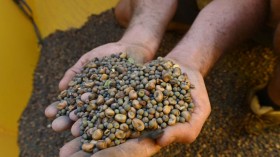To eradicate the invasive African snails they had previously introduced to the ecosystem, authorities are about to release 5000 Polynesian snails in Tahiti.
The predatory rosy wolf snail was introduced to French Polynesia as a solution when the invasive African giant land snail took over the region.
5000 Polynesian Snails vs. Invasive African Snails
Unfortunately, the rosy wolf snail, which can move three times as fast as a regular snail, preferred to eat the tiny, endemic partula snails.
With more than 5,000 of the snails coming back to the island after being bred in captivity, the Partula snails are now slowly regaining health after their bouts with threats of extinction.
This is said to be the largest-ever release or rewilding of an "extinct in the wild" species.
Numerous thousands of partula snails from 11 different species were raised at the Royal Zoological Society of Scotland, the London and Whipsnade Zoos, and the Saint Louis Zoo in the United States before being released on the islands of Moorea and Tahiti.
Each snail has a red, UV-reflective paint dot on its shell. The paint makes sure the nocturnal snail, which is one to two centimeters long, will fluoresce under UV torchlight to assist conservationists in monitoring the expanding populations.
Like Darwin's Finches
Despite their small size, Dr. Paul Pearce-Kelly, the ZSL curator of invertebrates and coordinator of the partula conservation program, said that these snails are extremely significant in terms of science, ecology, and culture.
Due to their adaptation to the ecosystem, Pearce-Kelly compared Polynesian snails to Darwin's finches in the snail world.
According to him, this joint conservation effort is unquestionably saving these species from extinction and demonstrating the power of zoos to stop the loss of biodiversity.
Early in the 1990s, the London and Edinburgh zoos saved the last few surviving members of several partula species to launch a breeding program internationally involving 15 zoos.
Also Read: 2 Invasive Mudsnails from New Zealand Found in Montana Creek
Partula Snail Recovery
Eleven species were saved after much success in preserving the snails.
This includes the last recorded member of Partula taeniata sumulans.
From its measly number when it was donated to the Edinburgh Zoo, the said species is now back to approximately 100 individuals, which experts considered a safe number.
According to Island Biodiversity, another Partula species, Partula faba, wasn't as fortunate.
The nine animals brought to Edinburgh Zoo were unable to reproduce in captivity, and the species went extinct in 2016.
The zoos started flying snails back to the wild nine years ago, working with the French Polynesian government to set up predator-proof snail reserves on the islands in preparation for their return.
Now, over 21,000 partula snails have been released on the islands, including 11 endangered species, as per the IUCN Red List, which has classified them as "extinct in the wild."
The most reintroductions have been made thus far this year.
By consuming rotting plant tissue and fungi, partula snails, also referred to as Polynesian tree snails, contribute significantly to the preservation of the health of tropical forests.
By releasing them back into the wild, the islands' ecological balance can be restored, The Guardian reported.
Relatd Article: Invasive, Destructive Giant Land Snails Puts Florida County Under Quarantine
© 2024 NatureWorldNews.com All rights reserved. Do not reproduce without permission.





